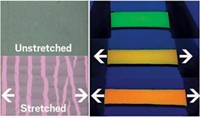Advertisement
Grab your lab coat. Let's get started
Welcome!
Welcome!
Create an account below to get 6 C&EN articles per month, receive newsletters and more - all free.
It seems this is your first time logging in online. Please enter the following information to continue.
As an ACS member you automatically get access to this site. All we need is few more details to create your reading experience.
Not you? Sign in with a different account.
Not you? Sign in with a different account.
ERROR 1
ERROR 1
ERROR 2
ERROR 2
ERROR 2
ERROR 2
ERROR 2
Password and Confirm password must match.
If you have an ACS member number, please enter it here so we can link this account to your membership. (optional)
ERROR 2
ACS values your privacy. By submitting your information, you are gaining access to C&EN and subscribing to our weekly newsletter. We use the information you provide to make your reading experience better, and we will never sell your data to third party members.
Materials
A Molecule Of Many Colors
Organic Chemistry: With rigid wings and a flexible core, a new compound can switch between two shapes and glow one of three colors
by Melissae Fellet
June 7, 2013
A new, flexible, multi-ring organic compound fluoresces red, green, or blue depending on its environment (J. Am. Chem. Soc. 2013, DOI: 10.1021/ja404198h). The molecule’s combination of rigid wings and a flexible center could serve as a general design strategy for molecular sensors, the researchers say.

The molecule, developed by a team of researchers, including Shohei Saito, Stephan Irle, and Shigehiro Yamaguchi of Nagoya University in Japan, has two rigid anthraceneimide wings on opposite sides of a floppy cyclooctatetraene core.

The wings can form a V shape or lie flat, allowing the molecule to fluoresce one of three different colors when hit with 365 nm ultraviolet light. When a polymer traps the molecule in its bent shape, the molecule emits blue light. When dissolved in dichloromethane, the wings lie flat, and the solution fluoresces green. In a crystalline state, the individual V-shaped molecules nest inside each other and produce a chemical species that glows red.
In each case, the molecule’s surroundings affect how the molecule bends or stacks together, and as a result, what color it glows. Because temperature and pressure could also influence such shape changes, similar molecules could serve as sensors, Yamaguchi says.





Join the conversation
Contact the reporter
Submit a Letter to the Editor for publication
Engage with us on Twitter